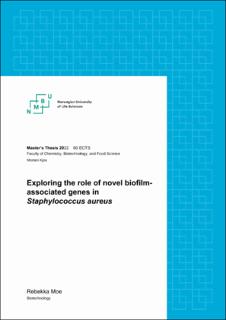| dc.contributor.advisor | Kjos, Morten | |
| dc.contributor.advisor | Morales Angeles, Danae | |
| dc.contributor.author | Moe, Rebekka | |
| dc.date.accessioned | 2022-11-21T13:24:17Z | |
| dc.date.available | 2022-11-21T13:24:17Z | |
| dc.date.issued | 2022 | |
| dc.identifier.uri | https://hdl.handle.net/11250/3033166 | |
| dc.description.abstract | Staphylococcus aureus er en opportunistisk humanpatogen bakterie med evnen til å forårsake en rekke alvorlige infeksjoner. Bakteriens suksess kan tilskrives dens mange varierte virulensfaktorer, inkludert dannelsen av biofilmer. Biofilmer er tredimensjonale bakterielle samfunn festet til en overflate, omgitt av en ekstracellulær matriks som består av ekstracellular DNA (eDNA), polysakkarider, og proteiner. Bakterier i biofilmer har en økt resistens både mot vertens immunforsvar og antimikrobielle midler. Dette begrenser behandlingsmulighetene ved en infeksjon. En gruppe enzymer kjent som peptidoglykanhydrolaser bidrar til det første stadiet i biofilmdannelsen, bestående av å feste cellene til en overflate. Biofilmdannelse er en kompleks prosess, og mange andre komponenter er involvert. Å forstå hvordan de ulike komponentene bidrar i dannelsen er nødvendig for å oppdage måter å bekjempe S. aureus biofilm-infeksjoner. I denne mastergradsavhandlingen ble derfor rollen til nye biofilm-assosierte gener utforsket i følgende tre deler.
Den antatte peptidoglykanhydrolasen SAOUHSC_00671 (heretter 00671) har tidligere blitt rapportert til å være involvert i biofilmdannelse. Ved å sammenligne egenskaper ved biofilmer dannet av en villtype- og en 00671-knockoutstamme, ble det oppdaget at 00671 endrer biofilmfenotypen i det første stadiet av dannelsen. De resterende resultatene i denne oppgaven indikerer imidlertid at 00671 ikke bidrar til biofilmdannelse i S. aureus i særlig grad. Det ble funnet en genetisk korrelasjon mellom 00671 og SsaA, en annen antatt peptidoglykanhydrolase, i planktoniske celler og biofilmer. Korrelasjonen antyder at det er et intrikat samspill mellom peptidoglykanhydrolaser i S. aureus, hvor cellen kan oppfatte mangel på hydrolaseaktivitet av ett enzym og oppregulere andre peptidoglykanhydrolaser for å opprettholde homeostase.
I tillegg ble den nyoppdagede cellemorfologideterminanten i S. aureus, SmdA, vist å være involvert i biofilmdannelse i stammen NCTC8325-4, og mekanismen ble knyttet til det biofilmassosierte ica-operonet. Ved å nedregulere uttrykket av SmdA ved bruk av CRISPRinterferens, ble det observert en reduksjon i biofilmmasse og «polysaccharide intracellular adhesins». I samsvar med disse observasjonene ble det ikke sett noen reduksjon i biofilmdannelse for SH1000 og JE2, stammer assosiert med biofilmdannelse uavhengig av icaoperonet.
For å oppdage nye gener i S. aureus involvert i det første stadiet av biofilmdannelse, ble en genomomfattende screen utført ved brukt av et CRISPR-interferensbibliotek. Dette avdekket tre nye mulige gener involvert i denne prosessen; to hypotetiske proteiner kodet av SAOUHSC_0957 og SAOUHSC_02888, og xdrA. XdrA regulerer utslipp av eDNA og uttrykk av overflateproteinet SpA, men mekanismen er fortsatt ukjent. Rollen til disse genene i biofilmdannelse bør studeres videre. | en_US |
| dc.description.abstract | Staphylococcus aureus is a major opportunistic pathogen in humans. Its success can be attributed to its variety of virulence factors, including the formation of biofilms. Biofilms are sessile three-dimensional bacterial communities attached to a surface, embedded in an extracellular matrix consisting of extracellular DNA (eDNA), polysaccharides, and proteins. Bacteria in biofilms exhibit increased resistance to the host’s immune system and antimicrobials, limiting infection treatment options. A class of enzymes known as peptidoglycan hydrolases facilitate the first stage of biofilm-formation, the attachment of cells to a surface, by releasing adhesive eDNA. However, biofilm-formation is a complex process, and many other components are involved. Understanding how these components contribute to the formation is key to discovering ways to combat S. aureus biofilm infections. Therefore, this thesis explored the role of novel biofilm-associated genes in the following three parts.
This work explored the function of putative peptidoglycan hydrolase SAOUHSC_00671 (hereafter 00671), previously reported to be involved in biofilm formation. By comparing features of biofilms formed by a wildtype- and a 00671-knockout strain, a different attachment phenotype was discovered. However, the results in this thesis indicate that 00671 does not majorly contribute to biofilm-formation in S. aureus. Interestingly, a genetic correlation between 00671 and SsaA, another putative peptidoglycan hydrolase, was found in planktonic cells and biofilms, which may have counteracted the effect of knocking out 00671. The correlation suggests that there is an intricate interplay between peptidoglycan hydrolases in S. aureus, where cells can sense a lack of hydrolase activity by one enzyme and upregulate other peptidoglycan hydrolases to maintain homeostasis.
Additionally, the newly discovered S. aureus cell morphology determinant SmdA was demonstrated to be involved in biofilm-formation in strain NCTC8325-4, and the mechanism was linked to the biofilm-associated ica-operon. By depleting SmdA using CRISPR interference, a decrease in biofilm mass and polysaccharide intracellular adhesins were observed. Consistent with these observations, no decrease in biofilm-formation was seen for strains SH1000 and JE2, strains associated with biofilm-formation independently of the ica-operon.
Finally, to screen S. aureus for new genes involved in attachment, the initial phase of biofilm formation, a CRISPR interference screen was performed using a genome-wide CRISPR interference library. This revealed three novel putative attachment-related genes; two hypothetical proteins encoded by SAOUHSC_0957 and SAOUHSC_02888, and xdrA. XdrA regulates eDNA release and the surface protein SpA, although its mechanisms is still largely unknown. The role of these genes in biofilm-formation should be studied further. | en_US |
| dc.language.iso | eng | en_US |
| dc.publisher | Norwegian University of Life Sciences, Ås | en_US |
| dc.rights | Attribution-NonCommercial-NoDerivatives 4.0 Internasjonal | * |
| dc.rights.uri | http://creativecommons.org/licenses/by-nc-nd/4.0/deed.no | * |
| dc.title | Exploring the role of novel biofilm-associated genes in Staphylococcus aureus | en_US |
| dc.type | Master thesis | en_US |
| dc.description.localcode | M-BIOTEK | en_US |

